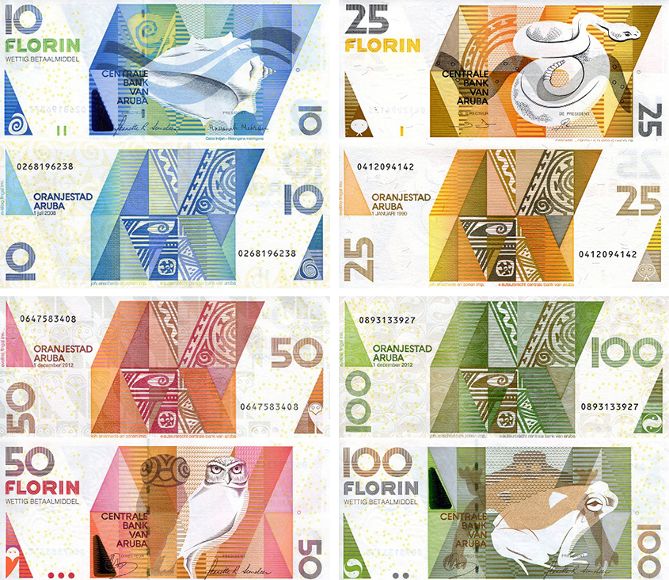(Oranjestad)—Aruba Today is proud to officially introduce a new segment called Did you know about…?, where we dive into some (historical) facts of Aruba, its culture and way of living. In this first edition, we look back at the Aruban florin: its history, design and symbolism.
In Aruba, we know the 5, 10, 25 and 50 cent coins, along with the 1 and 5 Florin coin. Aruban Florin bills include the 10, 25, 50, 100, and rarely, the 200 bills. In Papiamento we call our currency Florin, but the umbrella term for money is placa. Cents are called cen (pronounced: seng), both in the singular and plural form. Most coins are circular and their size depend on their worth. However, the 50 cent coin is easily recognizable by their square shape, as is the 5 Florin coin by their golden color. Every coin has the Aruban emblem carved on it, with the other side displaying the worth of the coin. The bigger 1 and 5 florin coins, however, contain the carving of the emblem on one side, while displaying the side profile of the Dutch king, Willem-Alexander, on the other side. When his mother, Princess Beatrix, was reigning queen, it was her profile that was carved on the two coins.
Outdated Aruban coins and their names
In the past, Aruban coins had distinctive names and also varied in worth. For example, a 5-cent coin was once called Dos placa; 10-cent coins were called debchi; 25-cent coins were called diez placa and the 50-cent coin was once called Yotin (pronounced: jo-teen). We also used a distinctive coins worth 2 ½ cents, called placa too. However, this last coin is no longer in use and has become a relic of Aruban money. Back then, the 5-Florin coin used to also be square, but now it is circular.
Aruban bills: their design and symbolism
The Aruban Florin collection contains a variation of colorful bills, displaying incredibly detailed and beautiful designs that tell the story of Aruba on a single piece of paper.
Prior to 2019, the Aruban Florin bills were relatively simpler in design compared to now, but still included beautiful designs and colors, often depicting local animals. These past designs were made by the Aruban artist Everino Fingal in 1990 up to 2019. Between 1990 and 1993, the 5 Florin coin was a bill. The Fingal designs also included a 500-Florin bill, which has now been discontinued.
In 2019, the Central Bank of Aruba commissioned a new design of the Aruba Florin bills, this time selecting artist and former art teacher, Nigel Matthew, to present his new design. Matthew kept the tradition of including local animals and the familiar colors on the bills. However, he included additional designs that represent the Aruban culture and link to the Indigenous inhabitants that were the first to set foot on the island.
Current design and symbolism
10 florin
On the 10-florin bill, you can see a Turtuga blanco (white turtle). The blue color symbolizes the blue Caribbean Sea. You can also see the ruins of the Bushiribana Gold Mill Ruins, a coral motif, and the symbols of Cas Floria (traditional Aruban house design) with a piece of mosaic.
25 florin
On this orange bill, you can see an Aruban medicinal plant called Shoshoro. The birds Trupiaal, Shoco, rock drawings, and the symbols of Cas Floria with a piece of mosaic are also depicted. There is also a Purun di ceramica (clay pot), in reference to the relics left behind by our indigenous ancestors.
50 florin
On this bill, we see the Cododo (blue lizard found on the ABC islands), Cangreu di tera (land crab), Willem III Tower, and again the symbols of Cas Floria with a piece of mosaic, as well as a beach plant called Banana di rif. The colors are pink/purple.
100 florin
This bill is green in color, representing nature. Here we see the Yuwana (Iguana), Aloe, Toteki (lizard), the symbols of Cas Floria with a piece of mosaic, and a dance group performing the Baile di cinta (forkloric dance with silk ribbons).
200 florin
There is another bill with a value of 200 dollars. The brown color symbolizes the earth of Aruba. Here we see the Dornasol and the Warawara—both local birds, along with the symbols of Cas Floria with a piece of mosaic, the Tuna cactus plant, and the Caha di orgel (folkloric instrument, used for many traditional songs).
Extra fact:
the word “florin” supposedly is named after the Italian city of Florence or it’s a reference to the Italian word “florino”, both explanations related to historical Italian currencies.
Source: Placa, placa, placa by the National Library of Aruba

















